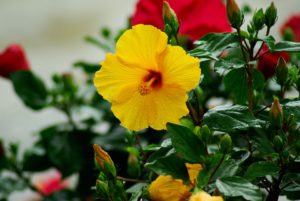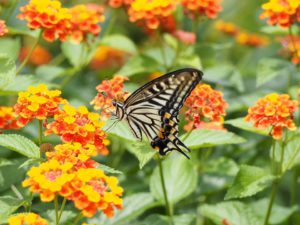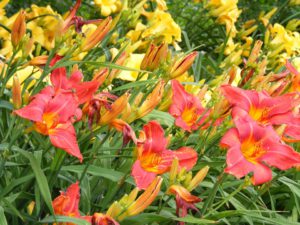8 Easy Steps in Growing a Flower Garden

Beautiful, elegant, colorful, restful, peaceful, and inviting is what describes a garden that’s planted with flowers of different sorts. This is one of the beauties of nature that is breath-taking which makes investing in a flower garden so rewarding.
I have worked in beautiful gardens and have seen the change not only a well-designed garden brings but a garden that is bursting with flower blooms giving that color pop which is so amazing. In this article, we will be discussing how to grow beautiful flowers from your home garden.
Perhaps you may have an existing garden that needs a facelift or you may be thinking of installing a flower garden bringing a change that’s necessary not only for beauty but to increase your properties value well look no further you have come to the right place to learn 8 easy steps in growing a flower garden.
8 Easy Steps in Growing a Flower Garden

- The location
- The soil type
- Choice of flowering plants
- Watering methods
- Fertilizers matters
- Garden insect pest identification and control
- Disease identification and control
- Deadheading for health and flower bloom
1. The location
The first step in the right direction when it comes to growing a flower garden is planting in the right location. The right location depends on the light requirements of the flowers that you choose to grow. Some flowering plants love the full sun and will not accept anything less while others prefer filtered light or partial shade. So get to know your plant light requirement and plant accordingly.
2. The soil type
The soil type is another factor to consider, before installing flowers it is best to have a soil ph test done to see what your soil may be lacking and adjust accordingly. The soil structure should be another factor to consider, does the soil has poor drainage, does it retain moisture is what you should consider.
If the soil has poor drainage or too sandy then adding organics will help to condition the soil to meet your garden plants’ needs.
3. Choice of flowering plants
This is where a lot of persons make a poor selection because they just don’t know the plant type. Besides knowing the light requirements of your garden plants having a good understanding of the type of flowering plants will go a long way for garden success.
Flowering plant type

- Annuals
- Perennials
- Biennials
Annuals
Annuals are plants that complete their life cycle in one growing season then dies. The life cycle is complete from germination to the production of seeds.
Perennials
Perennials are plants that live for more than 2 seasons or from year to year, the height and diameter of these plant types can be controlled by pruning which requires some know-how for this procedure.
3. Biennials
Biennials are flowering plants that spend their first year putting forth leaves, stems, and roots. Then they go through a period of overwintering or they go into a dormant state, the second year these plants put forth or produce flowers.
Having this bit of knowledge will help in understanding the characteristics or the nature of the flowering plants you choose for your garden.
4. Watering methods
One reason why plants die is because of not knowing how much water to give. Too much can be detrimental as well as too little. When purchasing your flowering plants ask questions one of which is how much water to give. If your buying seeds read the package to understand the requirements for that plant species to survive.

5. Fertilizers matters
Fertilizers are plant nutrients, quick release, or water-soluble fertilizers are taken up quickly by the plant’s roots a word of caution however, overuse of these fertilizers can cause plant injury such as wilting of the plant because of water lost. Before applying this type of fertilizer read and follow the manufactures direction for the best results.
Slow-release fertilizers are released slowly over a period of time as they breakdown because of heat and moisture. Because of the mode of action of slow-release fertilizers, there is no need to concern yourself about plant burn but read the manufactures label and follow as directed.
6. Garden insect pest and how to control them
This is an issue that we all face but the good news is you can bring these insect pests under control, once the insect has been identified go ahead and apply the proper measures to eliminate them. Garden insect pests can be found on the leaves underside mostly a few may be on the surface, stems, and other plant parts.
The most common garden pest are mealybugs, thrips, whiteflies, spider mites, scales, aphids, slugs, and snails. The insect world is vast and to try to include the numbers and insect type is beyond the scope of this post. But as a rule whichever plant you’re thinking of installing find out from your garden nurseryman about garden pests to watch out for and how to bring control.
7. Disease identification and control
The most common issues that encourage plant disease is planting too closely. Give your garden flowers proper spacing for good air circulation, plants that are so close till they grow into each other or begins to rub are not good. If plants are already established but are rubbering then the use of a hand pruner by removing all or a part of the stem to create some space for proper airflow is ideal.
Overwatering is another issue that leads to root rot, know your plants watering needs and give that amount and no more, allow the soil to dry out somewhat before applying water again.
A soil that has poor drainage contributes to root rot, so from the start of your flower garden before planting, ensure that the soil that’s being used is ideal. Good garden soil or adding organics to native or existing soil should offer help.
8. Deadheading for health and flower bloom

Deadheading is the process of removing spend or fade flowers, the removal of these old flowers by pinching will encourage a fuller plant with fresh bloom.
Additional information
1. Ensure that the soil is loose to make installation easy, soil that is loose or cultivated will encourage the quick establishment of plant roots.
2. Plants that are short even at maturity should be installed in the front row of the garden bed.
3. Medium size plants should be placed in the middle.
4. Taller plants at the back, now you can break the rules somewhat and place some of the shorter plants in the middle or center of the plant bed.
5. Ensure that plants that are grouped together have the seem light and water requirements.
The final word on how to plant flowers
Constructing a flower garden is that simple, the presence of flowers changes the atmosphere with their beauty and texture. There is nothing more beautiful than a garden with an array of flower bloom giving that tropical look so if you haven’t as yet now is the right time to get started on that flower garden you will be so happy that you did as you create your garden paradise with a tropical feel.
About the author
Norman loves being in the garden, both at home and for his job....
he is 'Natures Little helper' being outdoors, growing his vegetables and flowers from an early age.
Now having spent over 22 years in the profession he want to give some of his knowledge to others...
his vast array of hints and tips you will find scattered over this site will help you no end growing plants in your garden.

Your images are so pretty and colorful. You are right about working around flowers, that must be fun, even in frustrating times. I do not have a green thumb, so the information may seem elementary for some, important to me. My lack of knowledge and the unfriendly soil condition combined to make my entries into flowering plants limited. There were zinnias in borders around the house, until kids and playing outside and a couple of rattlesnakes changed the plan. We have lived in some pretty under-populated areas!
The sandy soil grew such beautiful zinnias, but our tight packed slick mud that was at the next place worked for Bulb growing. Not so well for zinnias, but roses did well. Now with my interests going back to the colorful beds that flowering plants produce, I have been interested in learning a bit more. How early should I plant my seedlings before transplanting? 4 weeks? 8 weeks? It is too late for this summer but if I would get going next spring, planning now would give me a while to get beds ready.
Hello so happy to meet you and thanks so much for those kind words. So sorry to hear about how you had to change your plans especially if snakes are involved but it is so good to know that nobody got bitten that would have been really awful.
The planting instruction should be on the seed package this will give the right time for your seedlings to grow healthy. Just follow the instruction. I hope this helps and all the best for you.
I’m, mostly, reluctant when it comes to planting mostly because of insects but this beginner’s guide on how to plant flowers is a MUST have/know. It made me look at growing a flower garden on a completely different angle. If every green space lover could know these easy 8 steps, I’m sure we would be well-armed enough to build the most beautiful landscapes.
I am so happy to help and wishing you good success with your garden project.
what a fantastic post you have here on how to grow plant flowers, I must say that I am lucky to stumble upon this post, I just completed my vegetable garden and I was looking towards growing a plant flower Gardens until I stumbled upon this post of yours, I must say it is so chock-full of information that I have been looking for to help me grow my plants flower garden…
thanks for sharing and I can’t wait to start utilising the tips given here
Thank so much, you are welcome. Happy to help and all the best to you.
wow these is a very formative website. it made me to understand the different type of soil or land and the type of flower to planted on it.
these your website is a well arranged website is such a way that even your graphic design’s cannot not be compared with other’s because it is very beautiful.
i appreciate you for swinging these wonderful news my way and i will make sure i put it into practice. kudos to you i love everything about you website.
Thanks so much for those kind words, I am so happy to help and that you found my post helpful. Wishing you all the best.
Hey nice article you have there, your thoughts are indeed invaluable. I have learnt a whole lot from this article most especially the aspects of choosing a preferable flowering plants and the watering system to engage in. However, having known the different categories of flowering plants, I will definitely do well to choose flowering plants that can last more than a year
I am so happy to help, thanks so much for your kind words and wishing you the best of success. Have a good day.